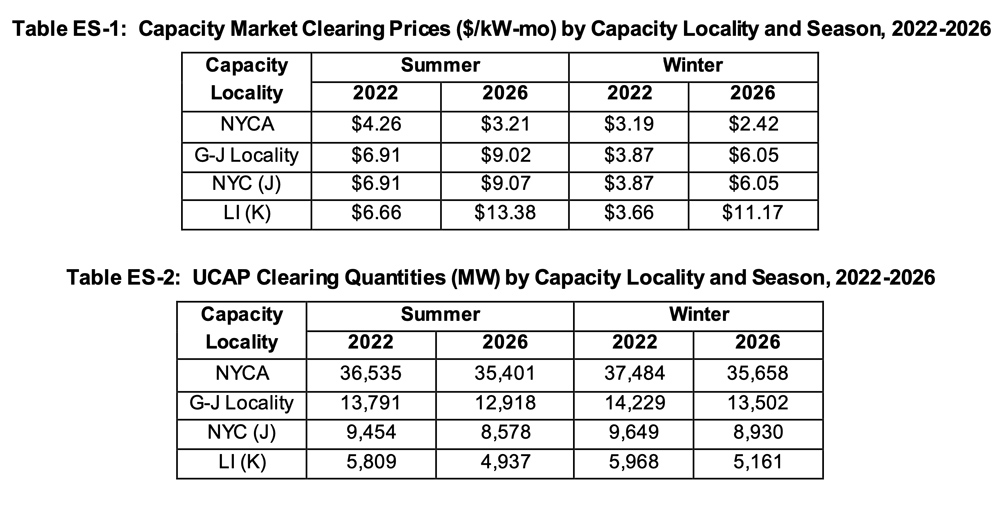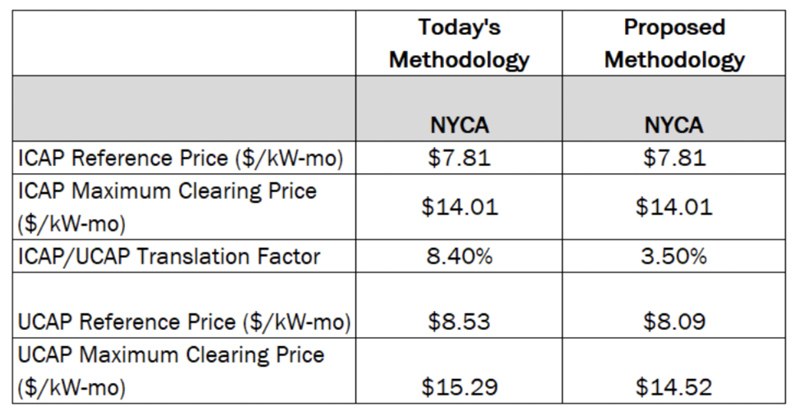
Stakeholders last week discussed NYISO’s comprehensive mitigation review proposal and presentations on related consumer and market impacts from implementing changes to the ISO’s buyer-side mitigation (BSM) rules.
The ISO is developing a proposal to help ensure that the capacity market still results in just in reasonable outcomes after an influx of thousands of megawatts of state-supported resources and will at the same time succeed with FERC and avoid any unnecessary litigation, Michael DeSocio, NYISO director of market design, told the Installed Capacity (ICAP) Market Issues Working Group.
“We’re very focused on making sure that the package of changes supports the goal here,” DeSocio said.
New York’s Climate Leadership and Community Protection Act (CLCPA) requires the state to procure large amounts of renewable energy to get to zero-emission electricity by 2040, and similar efforts around the country are challenging regulators, as well as grid and wholesale electricity market planners.
NYISO also presented on the methodology used to measure market impacts, and the Market Monitor, Potomac Economics, presented on capacity accreditation and related consumer impacts evaluation.
 The NYISO MMU says that marginal accreditation allows the more efficient resource to be selected. | Potomac Economics
The NYISO MMU says that marginal accreditation allows the more efficient resource to be selected. | Potomac Economics“The intent here is to assess the marginal accreditation of all resources … and we have about a six-week window to do that from when the [Installed Reserve Margin] studies are finalized and when we need to have these accreditation values determined,” DeSocio said.
“We are proposing to value the capacity accreditation of all resources based upon their marginal reliability contribution,” said Zachary Smith, manager of capacity market design.
NYISO wants to complete these reforms in time for the Class Year 2021 BSM evaluations and intends to address capacity accreditation in different phases, with the Phase 1 tariff changes to be discussed through year-end 2021, and Phase 2 discussion of procedures and details expected to start around January and run throughout 2022. (See NYISO Reviews Mitigation Efforts, Updates Timeline.)
Market Outcomes Analysis
NYISO in August introduced Analysis Group’s study that is modeling 10-year capacity supply and demand curves and identifying the resulting market outcomes to support BSM rule revisions, and the consultants presented the draft study results on Friday.
The purpose of the analysis is to determine whether the NYISO capacity market will support the continued achievement of resource adequacy in the state of New York through competitive capacity market auctions administered in concert with the rollout of CLCPA resources, said Paul Hibbard, Analysis Group principal.
Specifically, the study seeks to answer two questions:
a) With the proposed BSM reforms in place, will the NYISO capacity market continue to produce competitive market outcomes?
b) With the proposed BSM Reforms in place, will the NYISO capacity market continue to provide financial incentives for the retention and addition of resources needed to maintain power system reliability?
Importantly, while the results for 10 years out – 2032 – are necessarily more uncertain, the results of modeling various scenarios in 2032 are consistent with the observations based on the 2026 model year, the study said.
Analysts realized that the “load scenario in the 2021 Gold Book was closer to the progression of peak load over time in the Grid in Transition study, which is the basis of our load generation assumption, so we adapted peak load to be consistent with that,” Hibbard said.
Changes underlying the results for 2026 include significant changes to the assumed resources on the system compared to 2022. Specifically, in the four years since 2022:
- Fossil fuel ICAP has decreased by 2,834 MW;
- Onshore wind has increased by 244 MW;
- Offshore wind has increased by 1,200 MW;
- Grid-connected solar photovoltaic capacity has increased by 5,000 MW;
- Battery storage resources (two-hour and four-hour) has increased by 1,571 MW.
Despite the significant addition of zero-offer CLCPA resources by 2026, the market retains 31,485 ICAP MW (29,309 UCAP MW) of thermal, hydro and nuclear capacity, and 5,772 ICAP MW (5,650 UCAP MW) of other resources (e.g., biogen, pumped storage, imports, Special Case Resources). In total, the market supply curve includes 42,939 ICAP MW (37,985 UCAP MW) in 2022, and 48,021 MW ICAP (37,034 MW UCAP) in 2026.
 The tables contain the results of the analysis for the New York Control Area (NYCA) as a whole, and for each of the NYISO capacity market localities, providing expected prices in dollars per kilowatt-month ($/kW-mo) and clearing quantities in unforced capacity megawatts (UCAP MW) by year, season, and locality. | Analysis Group
The tables contain the results of the analysis for the New York Control Area (NYCA) as a whole, and for each of the NYISO capacity market localities, providing expected prices in dollars per kilowatt-month ($/kW-mo) and clearing quantities in unforced capacity megawatts (UCAP MW) by year, season, and locality. | Analysis GroupSeveral stakeholder expressed concern that all fossil fuel resources would be treated comparably for capacity accreditation going forward.
“The intent is to evaluate all fossil fuel resources when we move forward with the accreditation approach,” DeSocio said. “We expect to run some sensitivities with more rigor in the next phase of the process.”
 NYISO is proposing to adopt the MMU…s recommendation to translate the ICAP Reference Price to a UCAP Reference Price using the derating factor of the peaking unit underlying each ICAP Demand Curve. | NYISO
NYISO is proposing to adopt the MMU…s recommendation to translate the ICAP Reference Price to a UCAP Reference Price using the derating factor of the peaking unit underlying each ICAP Demand Curve. | NYISOThe ISO’s intent is to try to perform that analysis and lay out some of those comparisons in the next phase, but at the moment “we don’t have the tools with the ability to run that type of analysis, so we need to work with GE to help develop those tools,” DeSocio said.
NYISO will address any stakeholder feedback at the October 29 ICAP meeting, including updates to tariff language if necessary, and at the November 2 meeting Potomac Economics and NYISO will present the consumer impact analysis of the capacity accreditation proposal.
The ISO plans to bring tariff updates before the Business Issues Committee and Management Committee in November.


